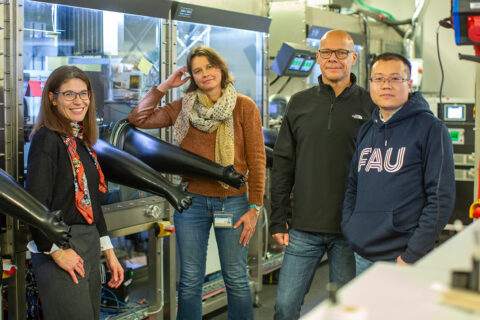Automated material development for solar cells

The research team from Friedrich-Alexander-Universität Erlangen-Nürnberg (FAU), the Helmholtz Institute Erlangen-Nürnberg (HI ERN) and the Karlsruhe Institute of Technology (KIT) led by Prof. Dr. Dirk M. Guldi and Prof. Dr. Christoph Brabec has developed a closed-loop workflow that can be used to find optimal high-performance materials for perovskite solar cells (PSCs) in a short space of time. The approach presented in the current Science study combines computer-aided modelling, autonomous synthesis platforms and quantum theoretical calculations for the characterisation of molecules in order to make predictions for suitable material compounds and to test the latter automatically.*
Until now, the design of molecular compounds that are suitable for semiconductor components has been based on trial and error. This method has a number of disadvantages: it is labour-intensive and inefficient. This is because the human ability to recognise patterns in huge, complex data sets is limited.
In contrast, the research team used machine learning (ML) models and trained them with experimental and computer simulation data to predict molecular structures and properties for optimal device performance. Around 100 molecules were sufficient for this.
Next came a series of optimisations. In the first round, the algorithm suggested 24 molecules. The team then synthesised and tested these. It turned out that they were already better than the current references. This was verified again in a second round of optimisation. The most efficient material candidates achieved an efficiency of up to 24 per cent, surpassing the previous reference value of 22 per cent.
Automated sample measurement
‘With the new approach, we can not only search systematically, but also narrow down the search area. In addition, the newly discovered chemical compounds can be optimised and tested for the desired material properties,’ explains Prof. Dirk Guldi, Chair of Physical Chemistry.
High-throughput screening (HTS) plays a central role here. These are automated laboratory systems that prepare, dose and measure a large number of samples in parallel. This method is not only more precise, it also reduces the time required in the research process and minimises human error. In future, it will be possible to search through material libraries containing millions of molecules in a short space of time and discover candidates that are optimal for the desired function of the components.
‘We assume that this technology will develop beyond solar energy into an innovation driver for other industries that want to develop new materials using high-throughput processes,’ explains Prof Christoph Brabec, holder of the Chair of Materials Science.
*doi: 10.1126/science.ads0901
Information:
Prof. Dr. Dirk M. Guldi
Lehrstuhl für Physikalische Chemie I
Tel. +49-9131-85-27340
dirk.guldi@fau.de
Prof. Dr. Christoph Brabec
Lehrstuhl für Werkstoffwissenschaften
Tel. +49-9131-85-25426
christoph.brabec@fau.de
The FAU Profile Centre Solar is a driving force for future research in the field of solar energy systems, for innovations and for relevant future-oriented research. What are our scientists researching at the FAU Profile Centre Solar? Find out for yourself!
Are you also interested in photovoltaic technologies? In the joint FAU and EnCN #FAUInsights lecture series, experts discuss the topic of photovoltaics and where the journey is heading.
